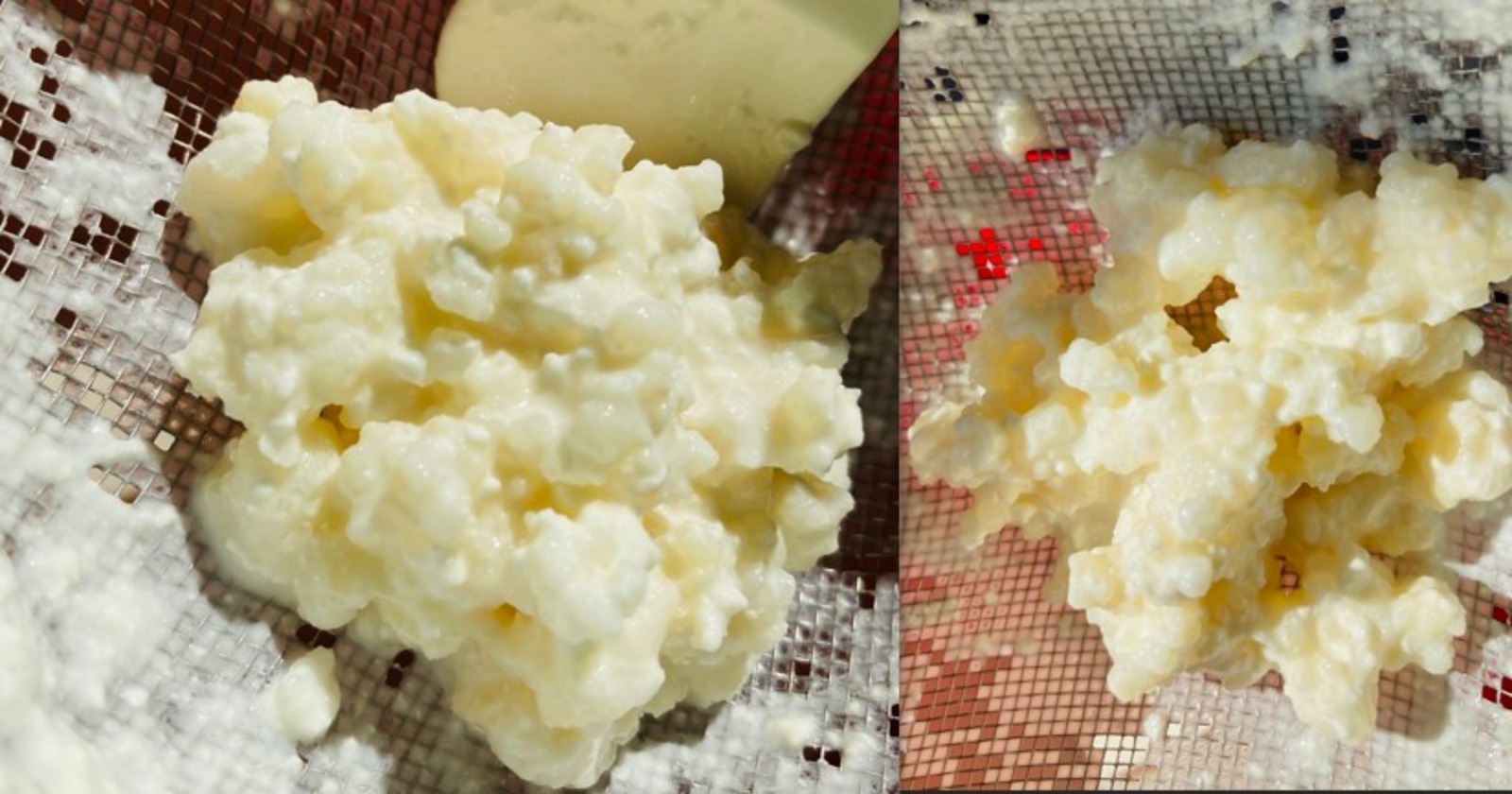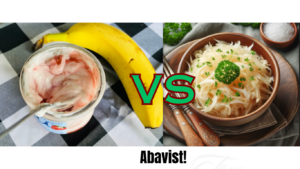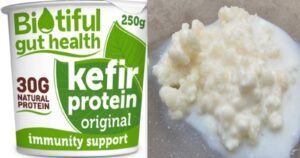Kefir Grains: The natural probiotic powerhouse used for centuries to create tangy, health-boosting kefir. Rich in beneficial bacteria and yeast, these grains ferment milk to produce a creamy, nutritious drink that supports gut health and digestion. Perfect for anyone looking to enhance their wellness routine with a delicious, homemade probiotic beverage.
Kefir grains are small, gelatinous clumps composed of bacteria and yeast living in a symbiotic relationship. They resemble small cauliflower florets and range in color from white to yellowish. A symbiotic culture of bacteria and yeast (SCOBY) used to ferment milk, resulting in a tangy, probiotic-rich beverage known as kefir.
The unique combination of beneficial microbes in kefir grains aids in digestion, boosts the immune system, and promotes overall gut health.
A symbiotic culture refers to a close and mutually beneficial relationship between different organisms that live together. In the context of kefir grains, a symbiotic culture of bacteria and yeast (SCOBY) means that these microorganisms coexist and interact in a way that benefits all of them.
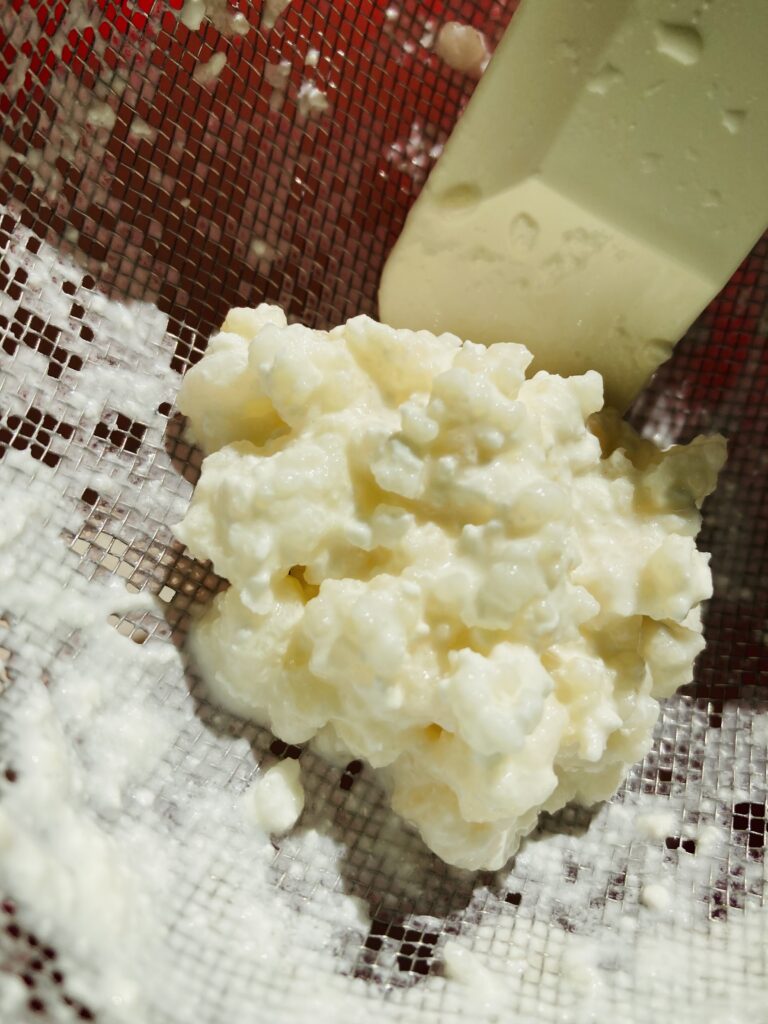
Appearance and Composition of kefir grains.
Appearance
- Shape and Size: Kefir grains are irregularly shaped, clumped, and can range in size from small grains like wheat kernels to larger pieces about the size of a walnut.
- Color: They are usually white or yellowish, resembling small cauliflower florets.
- Texture: Kefir grains have a gelatinous and slightly rubbery texture, feeling somewhat firm yet squishy when pressed between fingers.
Composition
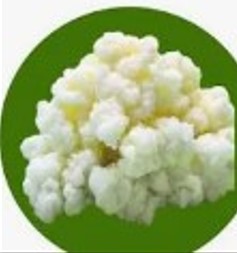
Kefir grains are composed of a complex and diverse community of microorganisms, embedded in a polysaccharide and protein matrix. The primary components include:
Microorganisms
- Bacteria:
- Lactic Acid Bacteria (LAB): These are the dominant bacteria in kefir grains, including species such as Lactobacillus, Lactococcus, and Leuconostoc. They are responsible for producing lactic acid, which gives kefir its tangy flavor.
- Acetic Acid Bacteria: These bacteria, such as Acetobacter, produce acetic acid, contributing to the acidic taste of kefir.
- Yeasts: Various species of yeasts, such as Saccharomyces, Kluyveromyces, and Candida, are present in kefir grains. They produce carbon dioxide and alcohol (in small amounts), contributing to kefir’s effervescence and mild alcoholic content.
Matrix
- Polysaccharides: Kefir grains contain a unique polysaccharide called kefiran, which forms the structural matrix of the grains and has potential health benefits, including antimicrobial and immunomodulatory properties.
- Proteins: The matrix also includes proteins that help maintain the structure and provide a habitat for the microorganisms.
Health Benefits of Kefir

Kefir is packed with probiotics, which are beneficial bacteria that help maintain a healthy gut flora. These probiotics can aid in digestion, prevent and treat diarrhea, and alleviate symptoms of irritable bowel syndrome (IBS).

The probiotics in kefir, especially Lactobacillus kefiri, can boost the immune system by inhibiting the growth of harmful bacteria. Kefir also contains other compounds, like polysaccharides, that have been shown to enhance immune function.
3. Bone Health

Kefir is a good source of calcium and vitamin K2, both of which are essential for bone health. Vitamin K2 plays a crucial role in calcium metabolism, helping to prevent osteoporosis and improve bone density.
4. Antibacterial Properties

Certain probiotics found in kefir, such as Lactobacillus kefiri, can inhibit the growth of various harmful bacteria, including Salmonella, Helicobacter pylori, and E. coli. This antibacterial effect can help protect against infections.
5. Lactose Intolerance Friendly

Many people who are lactose intolerant can consume kefir without issue. The fermentation process breaks down much of the lactose in milk, making it easier to digest.
6. Anti-inflammatory Properties

Kefir has been found to have anti-inflammatory properties, which can help reduce inflammation in the body. Chronic inflammation is linked to various health issues, including heart disease and cancer.
7. Mental Health Benefits

There is a growing body of research suggesting a link between gut health and mental health. The probiotics in kefir may help improve symptoms of depression and anxiety by promoting a healthy gut microbiome.

The probiotics and vitamins in kefir can promote healthy skin by improving gut health and reducing inflammation. Some studies suggest that consuming kefir can help manage skin conditions such as acne and eczema.

Kefir is rich in various vitamins and minerals, including B vitamins, vitamin D, calcium, magnesium, and phosphorus. These nutrients are essential for overall health and well-being.

The high protein content in kefir can promote a feeling of fullness, which may help with weight management. Additionally, the probiotics in kefir can influence metabolism and fat storage.
Incorporating kefir into your diet can offer these health benefits, making it a valuable addition to a balanced and nutritious diet. However, it’s always best to consult with a healthcare provider before making any significant changes to your diet, especially if you have any underlying health conditions.
Types of kefir grains
| Type of Kefir Grains | Description |
|---|---|
| Milk Kefir Grains | Traditional grains used for fermenting cow, goat, or sheep milk. |
| Water Kefir Grains | Used for fermenting sugar water or juice, suitable for those who are lactose intolerant. |
| Coconut Water Kefir Grains | Fermented coconut water offering additional health benefits. |
| Soy Milk Kefir Grains | Alternative for vegans and those with dairy allergies. |
Milk Kefir Grains
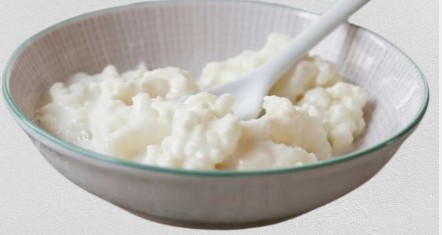
Description:
- Traditional kefir grains used to ferment animal milk.
- Typically white or yellowish, resembling small cauliflower florets.
- Rich in a variety of bacteria and yeast, which work together to ferment the milk.
Fermentation Process:
- The grains are added to milk (cow, goat, or sheep), where they feed on lactose, producing lactic acid, carbon dioxide, and small amounts of alcohol.
- The process usually takes 24-48 hours at room temperature.
Health Benefits:
- Probiotic-rich, supporting gut health.
- High in vitamins B1, B12, calcium, and vitamin K2.
- May improve digestion and lactose intolerance due to the presence of lactase.
Water Kefir Grains
Description:
- Also known as tibicos, these grains are translucent and crystal-like.
- Used for fermenting sugar water or fruit juice.
- Suitable for those who are lactose intolerant or prefer a dairy-free option.
Fermentation Process:
- The grains are added to a sugar-water solution or fruit juice, where they ferment the sugars, producing a lightly carbonated, probiotic-rich beverage.
- Typically ferments in 24-48 hours at room temperature.
Health Benefits:
- Probiotic-rich, aiding in digestion and gut health.
- Contains beneficial enzymes and vitamins.
- Hydrating and refreshing, especially when flavored with fruits or herbs.
Coconut Water Kefir
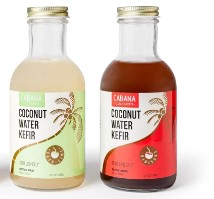
Description:
- Utilizes water kefir grains to ferment coconut water.
- Offers a dairy-free and low-sugar alternative to traditional kefir.
Fermentation Process:
- Water kefir grains are added to coconut water, fermenting the natural sugars.
- The process typically takes 24-48 hours.
Health Benefits:
- Hydrating and rich in electrolytes like potassium and magnesium.
- Probiotic content supports gut health.
- Contains bioactive compounds from coconut water that may offer additional health benefits.
Soy Milk Kefir
Description:
- Uses milk kefir grains to ferment soy milk.
- Suitable for vegans and those with dairy allergies.
Fermentation Process:
- Milk kefir grains are added to soy milk, fermenting the plant-based sugars.
- Typically ferments in 24-48 hours at room temperature.
Health Benefits:
- Probiotic content supports gut health.
- Soy milk provides protein, isoflavones, and essential amino acids.
- May help improve digestion and support immune function.
Kefir grains come in various types suitable for different dietary needs and preferences. Each type of kefir offers unique health benefits and can be used in diverse ways to enhance your diet with probiotics and other nutrients.

Step-by-step guide to cultivating your own kefir grains from scratch.
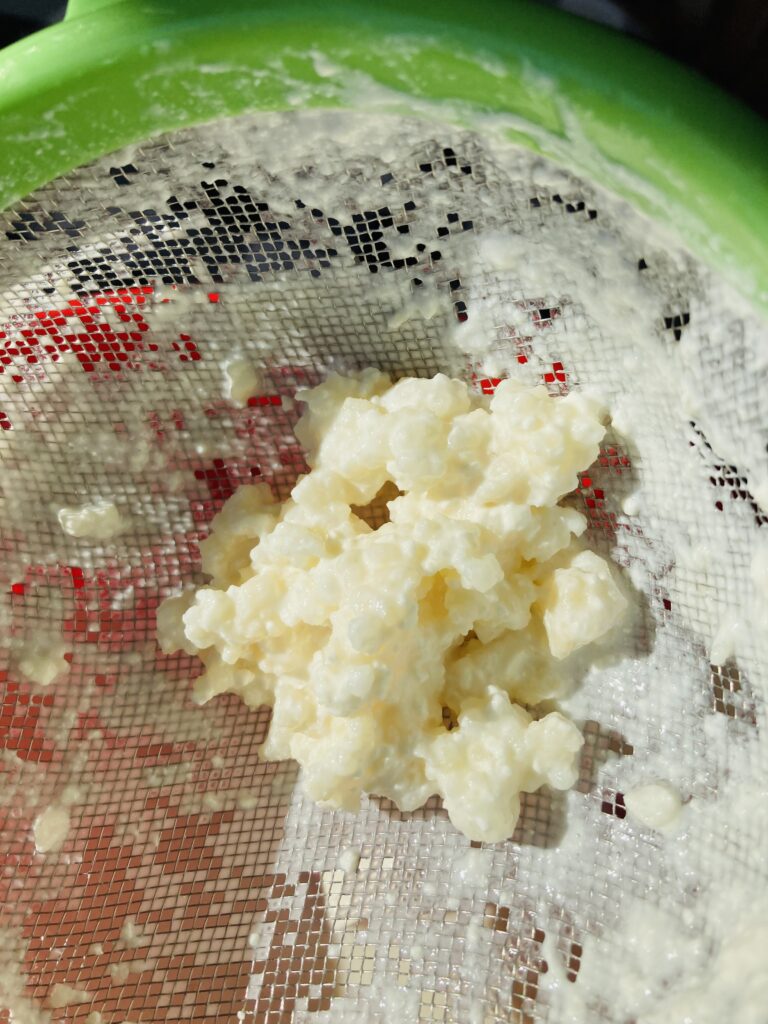
Cultivating your own kefir grains from scratch can be a rewarding process. Here’s a step-by-step guide to help you get started:
Items Needed:
- Fresh milk (whole milk is best, but you can use any kind)
- A clean glass jar
- A piece of cloth or paper towel
- A rubber band
- A non-metallic strainer
- A wooden or plastic spoon
Step 1: Preparation
- Select Fresh Milk: Start with fresh, high-quality milk. Raw milk is ideal, but pasteurized milk works as well. Avoid ultra-pasteurized milk, as it may not support the growth of kefir grains.
Step 2: Initial Fermentation
- Pour Milk into Jar: Fill a clean glass jar with milk. Leave some space at the top for expansion.
- Cover the Jar: Cover the jar with a piece of cloth or a paper towel and secure it with a rubber band. This allows airflow while keeping out dust and insects.
Step 3: Culturing the Milk
- Store in a Warm Place: Place the jar in a warm spot, ideally around 68-72°F (20-22°C). A kitchen counter away from direct sunlight is usually a good spot.
- Wait and Monitor: Let the milk sit undisturbed for 24-48 hours. You’ll notice it thickening and developing a tangy smell. This is the natural bacteria and yeast in the milk starting the fermentation process.
Step 4: Developing Kefir Grains
1.Check for Coagulation: After the initial 24-48 hours, check the milk for signs of coagulation. It should be thickened and slightly separated.
2. Strain and Repeat: Strain the thickened milk through a non-metallic strainer into a new clean jar. This strained liquid is your first batch of kefir. Return the strained solids (potential kefir grain precursors) to a new jar with fresh milk.
3. Continue Fermentation Cycles: Repeat the fermentation process with fresh milk every 24-48 hours. With each cycle, the solids you strain off should gradually develop into recognizable kefir grains, which are small, cauliflower-like clumps.
Step 5: Cultivating Mature Grains
1.Observe Growth: Over successive fermentation cycles, the grains should grow larger and multiply. This can take several weeks.
2. Maintain Cleanliness: Always use clean jars and utensils to prevent contamination.
3. Adjust Fermentation Time: Depending on your taste preference and the activity of the grains, you might adjust the fermentation time. Shorter times for milder kefir, longer times for tangier kefir.
Step 6: Using Mature Kefir Grains
- Harvest Grains: Once you have established kefir grains, you can start using them to make regular batches of kefir. Transfer the grains to fresh milk every 24-48 hours.
- Store Grains: If you need to take a break from making kefir, you can store the grains in a small amount of milk in the refrigerator for up to a week.
Important tips to Success when using kefir grains
- Temperature Control: Keep the fermenting milk at a consistent, warm temperature to encourage growth.
- Milk Quality: Use the best quality milk you can find to promote healthy grain development.
- Patience: Developing kefir grains from scratch can take time, so be patient and persistent.
- No Growth: If grains are not forming after several weeks, try using a different milk source or adjusting the fermentation temperature.
- Off Flavors: If your kefir develops off flavors, it might be due to contamination. Clean your equipment thoroughly and start a new batch.
Uses of Kefir Grains
- Fermented Beverages:
- Milk Kefir: Kefir grains are most commonly used to ferment milk, resulting in a tangy, probiotic-rich beverage. The grains consist of bacteria and yeast that feed on the lactose in milk, producing a slightly effervescent drink. Milk kefir is usually fermented at room temperature for 12-24 hours.
- Water Kefir: By using sugar water or fruit juice as a base, water kefir grains produce a refreshing, lightly carbonated beverage. This is a popular non-dairy alternative and can be flavored with various fruits, herbs, and spices.
- Coconut Water Kefir: Fermenting coconut water with kefir grains creates a hydrating and probiotic-rich drink. It’s particularly popular among those who prefer a dairy-free option and enjoy the natural sweetness of coconut water.
Smoothie Ingredient:
- Probiotic Boost: Adding kefir to smoothies is an excellent way to incorporate probiotics into your diet. The creamy texture of milk kefir blends well with fruits and vegetables, enhancing the nutritional profile of the smoothie.
- Flavor Enhancement: Kefir adds a tangy flavor that complements the sweetness of fruits like berries, bananas, and mangoes. It can also be mixed with leafy greens for a nutritious green smoothie.
Baking:
- Buttermilk Substitute: Kefir can replace buttermilk in recipes for pancakes, waffles, muffins, and cakes. It provides a similar acidity and consistency, which helps in leavening and adds a subtle tang to baked goods.
- Yogurt Substitute: In recipes calling for yogurt, kefir can be used as a one-to-one substitute. This works well in both sweet and savory baked items, adding moisture and enhancing flavor.
Marinades:
- Meat Tenderizer: The acidity and enzymes in kefir make it an effective marinade for tenderizing meats. It breaks down proteins, resulting in softer and more flavorful meat.
- Flavor Infusion: Kefir-based marinades can be seasoned with various herbs and spices to infuse the meat with additional flavors. Commonly used for chicken, beef, and lamb, kefir marinades are left on the meat for several hours or overnight.
Salad Dressings:
- Creamy Dressings: Kefir can be used to create creamy salad dressings by blending it with olive oil, lemon juice, garlic, and herbs. It adds a probiotic element to salads and a tangy taste that pairs well with greens.
- Flavor Enhancer: Kefir-based dressings can be customized with various ingredients such as mustard, honey, and spices to create a range of flavors, from tangy and spicy to sweet and savory.
Essential tips when caring for kefir grains
Caring for kefir grains involves several detailed steps to ensure they remain healthy and productive. Here’s an in-depth look at each aspect:
Feeding
Milk Kefir Grains:
- Regular Feedings: Milk kefir grains should be fed fresh milk every 24-48 hours. The exact frequency depends on the ambient temperature and the grain-to-milk ratio.
- Type of Milk: Use whole, pasteurized milk for best results. Raw milk can be used but requires more careful monitoring. Non-dairy milk alternatives can be used but may require occasional refreshment in dairy milk to maintain grain health.
- Amount: Typically, 1 tablespoon of grains per 1 cup of milk is a good ratio. Adjust based on fermentation speed.
Feeding Water Kefir Grains
- Sugar Water: Water kefir grains need to be fed a sugar-water solution. Dissolve 1/4 cup of sugar in 4 cups of non-chlorinated water.
- Minerals: Water kefir grains benefit from added minerals. A pinch of sea salt, a drop of molasses, or a piece of eggshell can provide necessary nutrients.
- Fruit Juices: Occasionally using fruit juices like coconut water can provide variety and additional nutrients.
Feeding Soy Milk Kefir Grains
- Type of Grains: Use water kefir grains or milk kefir grains that have been adapted to non-dairy milk. It’s best to introduce them gradually.
- Soy Milk Selection: Choose unsweetened, organic soy milk without additives like gums or preservatives, as these can interfere with fermentation.
- Ratio: Start with 1 tablespoon of kefir grains per 1 cup of soy milk.
Temperature Control for Kefir
Optimal Range: Keep milk kefir grains at 65-85°F (18-29°C) and water kefir grains at 68-72°F (20-22°C) for optimal fermentation.
Monitoring: Use a thermometer to monitor the temperature, especially in varying seasonal climates. Consider using a heating pad in colder climates or finding a cooler spot during hot weather.
Adaptation: If the temperature fluctuates, grains may require time to adapt. Slow changes in environment help them acclimate better.
Optimal Range for soy milk kefir at 68-72°F (20-22°C). Avoid temperatures below 60°F (16°C) or above 85°F (29°C), as these can stress the grains.
Fermentation Process for Kefir Grains
1. Preparation
- Equipment Needed: Glass jar, plastic or wooden spoon, plastic strainer, and a clean cloth or paper towel.
- Ingredients: Kefir grains, milk (preferably whole milk).
2. Activation (if using dried grains)
- Rehydration: Place the dried kefir grains in a small amount of milk (1 cup) and let them sit at room temperature for 24 hours.
- Rinsing and Feeding: Rinse the grains with non-chlorinated water and place them in fresh milk. Repeat this process daily until the grains become plump and start fermenting the milk (usually 3-7 days).
3. Fermentation Process
- Adding Milk: Place 1-2 tablespoons of active kefir grains into a clean glass jar. Add 2 cups of milk to the jar.
- Covering: Cover the jar with a cloth or paper towel secured with a rubber band to allow airflow while keeping out dust and insects.
- Fermentation Time: Let the jar sit at room temperature (65-75°F or 18-24°C) for 24-48 hours. The fermentation time can be adjusted based on the desired thickness and tanginess.
4. Separation and Straining
- Checking Readiness: The kefir is ready when it has thickened and has a tangy taste. The milk will appear separated into curds and whey.
- Straining: Pour the contents of the jar through a plastic strainer into another clean jar or bowl. Use a spoon to gently stir the kefir and help the liquid pass through the strainer, leaving the grains behind.
- Storage: Store the strained kefir in the refrigerator. It can be consumed immediately or left to ripen for another day to enhance the flavor.
5. Maintaining the Kefir Grains
- Rinsing: Rinse the grains with non-chlorinated water (optional). If you do rinse, make sure they are well-drained before adding them to new milk.
- Feeding: Transfer the grains to a new batch of milk to start the fermentation process again.
Tips for Optimal Fermentation
- Temperature Control: Maintain a consistent room temperature for best results. Extreme temperatures can affect the fermentation process.
- Milk Quality: Use high-quality milk, preferably whole milk, for richer kefir. Non-dairy milk can be used, but the grains need to be refreshed in dairy milk periodically.
- Cleanliness: Ensure all equipment is clean to prevent contamination. Avoid using metal utensils as they can react with the kefir grains.
Storage of Kefir Grains
Short-Term Storage
For short-term storage, up to a week, you can store kefir grains in the fridge. Here’s how:
- Use Soy Milk: Place the grains in a small jar with enough soy milk to cover them.
- Seal and Refrigerate: Seal the jar tightly and store it in the refrigerator.
- Check Regularly: After about a week, check the grains to ensure they are still healthy. If you see any changes in color or smell, it might be a sign that they need to be refreshed.
Long-Term Storage
For longer-term storage, there are a few methods you can use to keep your kefir grains healthy. These include alternating between different storage mediums and even freezing them.
Alternating Batches with Dairy Milk
- Switch to Dairy Milk: If you normally use soy milk, consider alternating batches with dairy milk. This can help keep the grains healthy and active.
- Fermentation: Allow the grains to ferment in the dairy milk for 24-48 hours.
- Rinse and Store: After fermentation, rinse the grains with filtered water and place them back in soy milk for storage.
Sugar Water Solution
- Prepare Sugar Water: Dissolve 1 tablespoon of sugar in 1 cup of water.
- Add Kefir Grains: Place the grains in the sugar water solution.
- Seal and Store: Store the jar in the refrigerator, checking weekly to ensure the grains remain healthy.
Freezing Kefir Grains
For very long-term storage, freezing is an effective method.
- Rinse the Grains: Rinse the kefir grains with filtered water to remove any milk residue.
- Dry the Grains: Pat the grains dry with a clean paper towel.
- Prepare for Freezing: Place the grains in a small zip-lock bag or a jar.
- Add Milk Powder: Add a small amount of milk powder to the bag or jar to protect the grains during freezing.
- Freeze: Place the bag or jar in the freezer. Kefir grains can be stored in the freezer for several months.
How to Revive Frozen Kefir Grains
- Thaw Gradually: Remove the grains from the freezer and let them thaw slowly in the refrigerator for a few hours or overnight.
- Rinse and Soak: Rinse the grains with filtered water and soak them in a small amount of milk or soy milk for a few hours.
- Resume Fermentation: Start fermenting as usual, but be aware that it might take a few batches for the grains to return to their full potency.
Tips for Maintaining Kefir Grain Health
- Temperature Control: Keep the storage temperature consistent. The fridge should be around 40°F (4°C).
- Clean Storage Containers: Always use clean jars and utensils to avoid contamination.
- Check Regularly: Inspect the grains regularly for any signs of spoilage, such as discoloration or off smells.
- Feed Periodically: If storing for a long time, refresh the grains by feeding them with fresh milk or a sugar solution every few weeks.
Kefir for Pet Health: Exploring the benefits of kefir for dogs and cats.
- Probiotic Boost:
- Gut Health: Kefir is rich in probiotics, which can help improve gut health by balancing the microbiome. This can lead to better digestion and nutrient absorption.
- Immune Support: A healthy gut can enhance the immune system, making pets less susceptible to infections and diseases.
- Digestive Aid:
- Relief from Diarrhea: The probiotics in kefir can help manage and prevent diarrhea by restoring the natural balance of gut bacteria.
- Reduction of Gas and Bloating: It can help reduce gas and bloating, which are common issues in pets.
- Anti-Inflammatory Properties:
- Joint Health: Kefir contains anti-inflammatory properties that can help reduce joint pain and improve mobility in older pets or those with arthritis.
- Skin Health: It can aid in reducing skin inflammations and allergies, promoting a healthier coat and skin.
- Allergy Relief:
- Regular consumption of kefir can help manage allergies by improving the immune response and reducing allergic reactions.
- Nutrient-Rich:
- Vitamins and Minerals: Kefir is a good source of essential nutrients such as calcium, magnesium, and vitamin B12, which are beneficial for overall health.
- Protein: It provides a good amount of protein, supporting muscle maintenance and repair.
Considerations and Precautions
- Lactose Intolerance:
- While kefir has less lactose than regular milk, some pets may still be sensitive. Start with small amounts to see how your pet reacts.
- Introduction to Diet:
- Introduce kefir gradually to your pet’s diet. Start with a small amount (like a teaspoon) and gradually increase the dosage to avoid any digestive upset.
- Quality and Source:
- Ensure you are using plain, unsweetened kefir. Flavored kefirs often contain added sugars and artificial ingredients that can be harmful to pets.
- Consultation with a Veterinarian:
- Before adding kefir to your pet’s diet, consult with a veterinarian, especially if your pet has any pre-existing health conditions or is on medication.
How to Serve Kefir to Pets
- Directly: Serve a small amount directly into their bowl.
- Mixed with Food: Mix it into their regular food.
- As a Treat: Freeze kefir into ice cube trays for a refreshing treat, especially during warmer months.
Recommended Dosage
- Small Dogs/Cats: Start with 1 teaspoon and gradually increase to 1 tablespoon.
- Medium to Large Dogs: Start with 1 tablespoon and gradually increase to 2-3 tablespoons.
Incorporating kefir into your pets’ diet can be a natural way to enhance their health and well-being. However, always monitor their reactions and adjust the amount accordingly.
Comparative Guide: Benefits and differences between milk kefir and water kefir.
| Milk Kefir | Water Kefir |
|---|---|
| Base Ingredients: Milk (cow, goat, or sheep) | Base Ingredients: Sugar water or coconut water |
| Probiotic Content: High | Probiotic Content: Moderate |
| Nutrient Content: Rich in proteins, fats, calcium, and vitamins | Nutrient Content: Lower in proteins and fats, some vitamins and minerals |
| Taste and Flavor: Creamy, tangy | Taste and Flavor: Light, slightly sweet |
| Suitability for Lactose Intolerant Pets: May not be suitable | Suitability for Lactose Intolerant Pets: Highly suitable |
| Fermentation Time: 24-48 hours | Fermentation Time: 24-48 hours |
| Primary Benefits: Gut health, immune support, bone health | Primary Benefits: Hydration, gut health, low-calorie probiotic option |
Historical Origins of Kefir Grains: Tracing the ancient history and cultural significance.
Ancient Origins
- Geographic Roots:
- Kefir grains are believed to have originated in the Caucasus Mountains, a region that spans parts of Russia, Georgia, Azerbaijan, and Armenia.
- The name “kefir” is derived from the Turkish word “keif,” which means “feeling good,” reflecting the health benefits associated with consuming kefir.
- Early Usage:
- Historically, kefir was made by fermenting milk in goatskin bags, which were hung near doorways so they would be agitated by anyone passing through.
- The grains were passed down through generations, often considered a family heirloom, signifying their value and importance.
Cultural Significance
- Caucasian Traditions:
- In the Caucasus region, kefir was regarded not only as a nutritious drink but also as a sacred food with numerous health benefits.
- It was believed that the grains were a gift from the gods, and families guarded them closely, often keeping their preparation methods secret.
- Spread to Other Regions:
- Kefir’s reputation for health benefits led to its spread beyond the Caucasus. It became popular in Eastern Europe and Russia, where it was consumed for its purported medicinal properties.
- Russian doctors in the 19th century began studying kefir for its probiotic qualities, and it was eventually introduced to Western Europe and the rest of the world.
Modern Day
- Global Popularity:
- Today, kefir is enjoyed worldwide and is celebrated for its probiotic content, which supports gut health and overall well-being.
- It is produced on a commercial scale but also remains a popular homemade beverage, allowing people to connect with its traditional roots.
- Cultural Revival:
- There is a growing interest in traditional foods and fermentation practices, leading to a revival of kefir-making at home.
- Kefir grains are often shared among communities and enthusiasts, continuing the ancient tradition of passing them down through generations.
Kefir grains are more than just a means to make a fermented drink; they represent a cultural and historical legacy that has been cherished and preserved through millennia. From their sacred beginnings in the Caucasus Mountains to their global recognition as a healthful beverage, kefir grains continue to be a symbol of traditional wisdom and nutritional heritage.
Resources
https://www.healthline.com/nutrition/9-health-benefits-of-kefir
